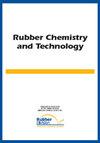通过双量子核磁共振分析耐热耐油弹性体中的交联密度及其分布
IF 1.2
4区 工程技术
Q4 POLYMER SCIENCE
引用次数: 0
摘要
双量子核磁共振(DQ NMR)用于表征一系列耐热耐油弹性体的交联密度、交联密度分布和缺陷水平。测量了各种缺陷水平、交联密度以及交联密度分布,结果取决于弹性体类型和化合物配方,包括硫化体系。溶胶组分缺陷水平通常与配方中添加的增塑剂浓度相关。极性侧链的存在似乎会对悬链末端部分产生额外的动态影响。由于弹性体成分和橡胶配方存在很大差异,因此无法将测得的交联密度与低应变模量进行有意义的关联。快速 Tikhonov 正则化和对数归一化拟合校正后的 DQ 积累曲线非常有用,有助于深入了解交联密度分布的模式和宽度。研究发现,耐热和耐油弹性体的交联网络具有高度异质性。交联密度分布可以用聚合物链结构(包括单体排序和交联点位置)来解释。硫化体系类型对交联密度分布性质的影响较小。由于耐油和耐热弹性体微观结构中存在极性差异,初级聚合物链交联点可能会从连续相中分离出来。这种微观形态的发展有利于固化分隔。仅使用 DQ NMR 就能深入了解橡胶中聚合物链结构和交联网络的性质。本文章由计算机程序翻译,如有差异,请以英文原文为准。
THE CROSSLINK DENSITY AND ITS DISTRIBUTION IN HEAT AND OIL RESISTANT ELASTOMERS BY DOUBLE QUANTUM NUCLEAR MAGNETIC RESONANCE
Double Quantum Nuclear Magnetic Resonance (DQ NMR) was used to characterize the crosslink density, crosslink density distribution and defect level in a series of heat and oil resistance elastomers. A wide range of defect levels, crosslink densities as well as crosslink density distributions was measured, and results depended on elastomer type and compound formulations including the vulcanization system. The sol fraction defect level generally correlated with the concentration of added plasticizer in the formulation. The presence of polar side chains appeared to cause additional dynamic contributions to the dangling chain end fraction. The large differences in elastomer composition and rubber formulations prevented any meaningful correlation of the measured crosslink densities with the low strain modulus. Fast Tikhonov regularization and log normalization fitting of the corrected DQ build up curve was extremely useful to provide insight into the modality and widths of the crosslink density distributions. A high degree of heterogeneity of the crosslink network of heat and oil resistance elastomers was found. Crosslink density distributions were explained in terms of the polymer chain structure comprising of monomer sequencing coupled with the position of the crosslinking sites. The type of vulcanization system had a lesser effect of the nature of the crosslink density distribution. The primary polymer chain crosslinking sites may become segregated from the continuous phase due to polarity differences seen in the microstructure of oil and heat resistance elastomers. The development of such micro-morphologies can favor curative partitioning. The sole use of DQ NMR can provide valuable insights into the nature of the polymer chain structure and crosslink network in rubber.
求助全文
通过发布文献求助,成功后即可免费获取论文全文。
去求助
来源期刊

Rubber Chemistry and Technology
工程技术-高分子科学
CiteScore
3.50
自引率
20.00%
发文量
21
审稿时长
3.6 months
期刊介绍:
The scope of RC&T covers:
-Chemistry and Properties-
Mechanics-
Materials Science-
Nanocomposites-
Biotechnology-
Rubber Recycling-
Green Technology-
Characterization and Simulation.
Published continuously since 1928, the journal provides the deepest archive of published research in the field. Rubber Chemistry & Technology is read by scientists and engineers in academia, industry and government.
 求助内容:
求助内容: 应助结果提醒方式:
应助结果提醒方式:


